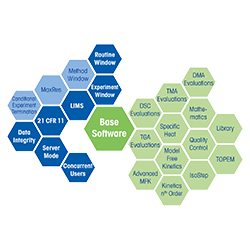Webinar – Thermal Analysis of Electronics
Main TA Techniques Used in the Field of Electronics
Program Overview
- Introduction
- Properties of Electronic Components
- Typical Questions
- Thermal Analysis
- Instrumentation and Applications
- Summary
Electronic engineering deals with electrical circuits involving components such as transistors, diodes, wires, and integrated circuits, which are usually mounted on printed circuit boards (PCBs). The application area and lifetime of these components depend strongly on their thermal and mechanical properties. Thermal analysis is key in the design and production of PCBs and electronic components.
In this webinar, we will show how thermal analysis is applied to investigate materials used in the electronics industry. We will present typical examples of samples measured by DSC, TGA, TMA, and DMA.
In this webinar titled "Thermal Analysis of Electronics," we demonstrate how thermal analysis is used to characterize the thermal and mechanical properties of many types of components and products, as well as to monitor production processes.
The Electronics Industry
Electronics deals with devices, systems, and circuits involving components such as transistors, diodes, wires, and integrated circuits. These devices are typically mounted on printed circuit boards.
Thermal analysis can be used to characterize the thermal and mechanical properties of many types of components and products and to monitor production processes.
Thermal Analysis of Electronics
The most important effects that can be analyzed by DSC are the melting point, melting range and melting behavior. DSC is also used to determine the heat of fusion, the glass transition, and oxidation stability.
TGA measures weight changes. The main applications of TGA are content determination, thermal stability, decomposition kinetics, and the analysis of composition.
TMA is normally used to study the expansion or shrinkage of materials and the glass transition.
DMA is used to determine the modulus and damping behavior of materials.




